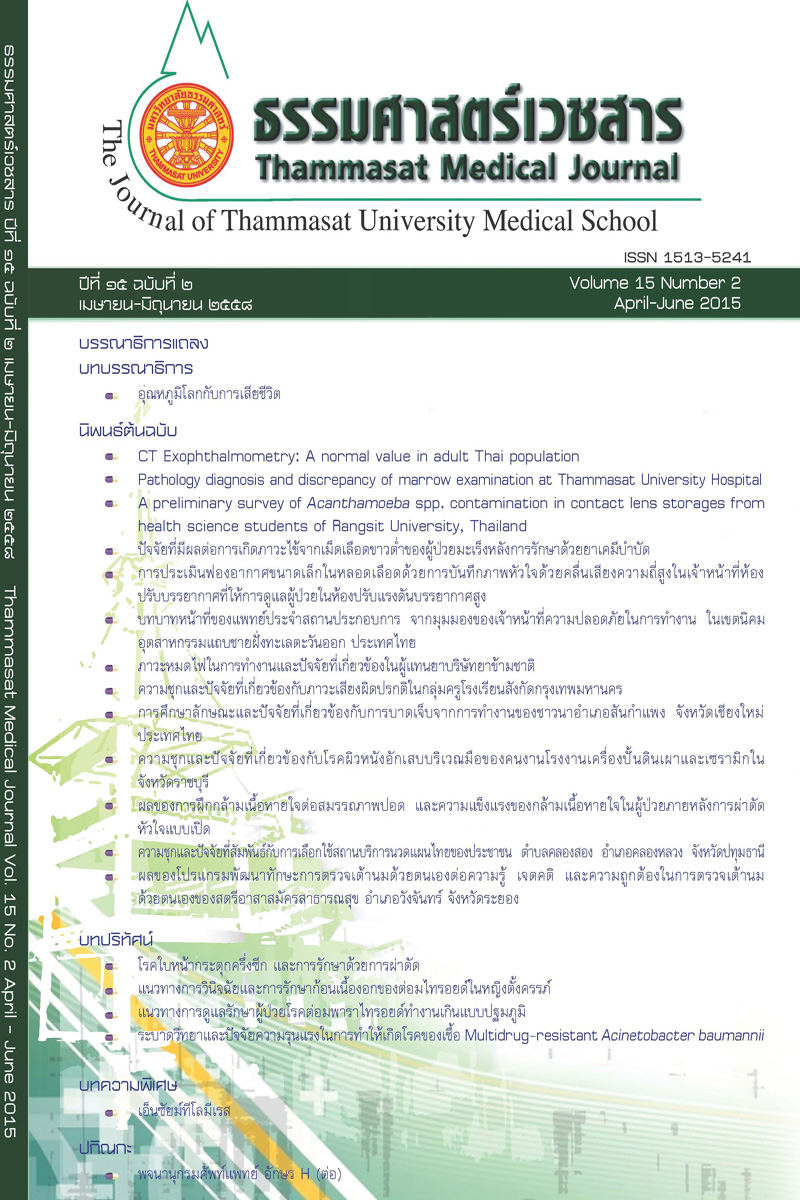Pathology diagnosis and discrepancy of marrow examination at Thammasat University Hospital
Keywords:
Marrow, Pathology diagnosis, Discrepancy, ไขกระดูก, การวินิจฉัยทางพยาธิวิทยา, ความคลาดเคลื่อนAbstract
Introduction: Pathology diagnosis based on histologic assessment of marrow is useful in establishing diagnosis, staging and monitoring treatment of various hematologic and non-hematologic diseases in clinical hematology practice. This study aimed to provide basic data for improvement of marrow diagnostic service.
Method: Pathology reports of 757 marrows were recruited from 1st August 2009 to 31st December 2011. The 262 cases were randomly chosen by systemic sampling for diagnosis review by another hematopathologist from different university hospital (third author). In case of discrepancy, the diagnosis was concluded by correlation with other laboratory tests, clinical information or additional ancillary tests.
Result: The indications for marrow biopsy were evaluation of malignancy 73.6%, abnormal CBC 20%, fever of unknown cause/infection 6% and rare congenital hematologic disease/metabolic disease 0.4%. Average turn around time was 2 days for initial diagnosis and 6 days for final diagnosis. Special stain and immunohistochemistry were done in 21.8% (average additional charge 43 Baht/case) and 29.8% of cases (average additional charge 564 Baht/case), respectively. Excluding the unsatisfactory specimen, the diagnoses reported were malignancy 23.3%, suspicious for malignancy 3.6%, infection 0.75%, non-neoplastic lesions 9.0%, reactive process 14% and no diagnostic abnormality 49.4%. Random review of the diagnosis detected kappa statistic of 89.6% with major discrepancy in 0.8% (2 cases). Both were false negative in detecting essential thrombocytosis and refractory anemia with excess blasts.
Discussion and Conclusion: Malignancy is prime concerned disease in pathology practice for being most common in indication, disease diagnosed and interpretation discrepancy. Marrow diagnostic service can be improved by clinical correlation, integrating multidisciplinary laboratory results, adequate specimen, good tissue preparation, morphologic diagnostic skill, special stains and immunohistochemical study.
Key words: Marrow, Pathology diagnosis, Discrepancy
ผลการวินิจฉัยทางพยาธิวิทยาและความคลาดเคลื่อนของผลการวินิจฉัยชิ้นเนื้อไขกระดูกที่โรงพยาบาลธรรมศาสตร์เฉลิมพระเกียรติ
นารี วรรณิสสร*, ผกาทิพย์ ศิลปมงคลกุล**, ไพศาล บุญสะกันต์***, นงลักษณ์ คณิตทรัพย์****
* ภาควิชาพยาธิวิทยาและนิติเวชศาสตร์ คณะแพทยศาสตร์ มหาวิทยาลัยธรรมศาสตร์
** ภาควิชากุมารเวชศาสตร์ คณะแพทยศาสตร์ มหาวิทยาลัยธรรมศาสตร์
*** ภาควิชาพยาธิวิทยา คณะแพทยศาสตร์โรงพยาบาลรามาธิบดี มหาวิทยาลัยมหิดล
**** ภาควิชาอายุรศาสตร์ คณะแพทยศาสตร์ มหาวิทยาลัยธรรมศาสตร์
บทคัดย่อ
บทนำ: การตรวจวินิจฉัยชิ้นเนื้อไขกระดูกทางพยาธิวิทยาให้ข้อมูลที่สำคัญในการวินิจฉัย ประเมินระยะโรคและการรักษาโรคในเวชปฏิบัติทางโลหิตวิทยา การศึกษานี้รวบรวมข้อมูลพื้นฐานเพื่อนำไปพัฒนาบริการตรวจวินิจฉัยชิ้นเนื้อไขกระดูก
วิธีการศึกษา: ข้อมูลรวบรวมจากรายงานผลตรวจชิ้นเนื้อไขกระดูกทางพยาธิวิทยา ๗๕๗ ราย ตั้งแต่ ๑ สิงหาคม ๒๕๕๒ ถึง ๓๑ ธันวาคม ๒๕๕๔ และสุ่มทบทวนการวินิจฉัย ๒๖๒ ราย โดยพยาธิแพทย์จากโรงพยาบาลอื่น เพื่อศึกษาความคลาดเคลื่อน กรณีพบความคลาดเคลื่อนจึงทำการสรุปผลการวินิจฉัย โดยพิจารณาผลตรวจจาก
ห้องปฏิบัติการอื่นร่วมกับข้อมูลคลินิกหรือการติดตามโรคและการย้อมเพิ่มเติม
ผลการศึกษา: ข้อบ่งชี้ในการตรวจชิ้นเนื้อไขกระดูกประกอบด้วย สงสัยมะเร็ง ร้อยละ ๗๓.๖ ความสมบูรณ์ของเม็ดเลือด (CBC) ผิดปรกติ ร้อยละ ๒๐ ไข้ไม่ทราบเหตุหรือสงสัยโรคติดเชื้อ ร้อยละ ๖ และโรคโลหิตวิทยาแต่กำเนิดที่พบไม่บ่อย ร้อยละ ๐.๔ ระยะเวลาในการรายงานผลเบื้องต้นเฉลี่ย ๒ วันและผลสมบูรณ์เฉลี่ย ๖ วัน มีการย้อมพิเศษ ร้อยละ ๒๑.๘ (ถัวเฉลี่ยค่าย้อมเพิ่ม ๔๓ บาทต่อราย) และย้อมอิมมูโนฮีสโตเคมี ร้อยละ ๒๙.๘ (ถัวเฉลี่ยค่าย้อมเพิ่ม ๕๖๔ บาทต่อราย) ชิ้นเนื้อที่ส่งตรวจและมีคุณภาพเพียงพอต่อการวินิจฉัยพบเป็นมะเร็งร้อยละ ๒๓.๓ สงสัยมะเร็ง ร้อยละ ๓.๖ โรคติดเชื้อ ร้อยละ ๐.๗๕ รอยโรคที่ไม่ใช่มะเร็ง ร้อยละ ๙ ปฏิกิริยาตอบสนอง ร้อยละ ๑๔ และไม่พบความผิดปรกติ ร้อยละ ๔๙.๔ การสุ่มทบทวนผลการวินิจฉัยพบสถิติ kappa ร้อยละ ๘๙.๖ และพบความคลาดเคลื่อนอย่างมีนัยสำคัญทางคลินิก ร้อยละ ๐.๘ (๒ ราย) ซึ่งเป็นรายที่ควรได้รับการวินิจฉัยว่าเป็น essential thrombocytosis และ refractory anemia with excess blasts
วิจารณ์ และสรุปผลการศึกษา: มะเร็งเป็นกลุ่มโรคที่สำคัญที่สุดในการตรวจวินิจฉัยทางพยาธิวิทยาชิ้นเนื้อไขกระดูก เพราะเป็นข้อบ่งชี้และเป็นโรคที่ได้รับการวินิจฉัยบ่อยที่สุด ประกอบกับพบความคลาดเคลื่อนอย่างมีนัยสำคัญ การวินิจฉัยไขกระดูกทางพยาธิวิทยาต้องอาศัยข้อมูลทางคลินิก สิ่งส่งตรวจและสไลด์ชิ้นเนื้อที่มีคุณภาพ ทักษะในการวินิจฉัยของพยาธิแพทย์ การย้อมพิเศษและการย้อมอิมมูโนฮีสโตเคมี
คำสำคัญ: ไขกระดูก, การวินิจฉัยทางพยาธิวิทยา, ความคลาดเคลื่อน


